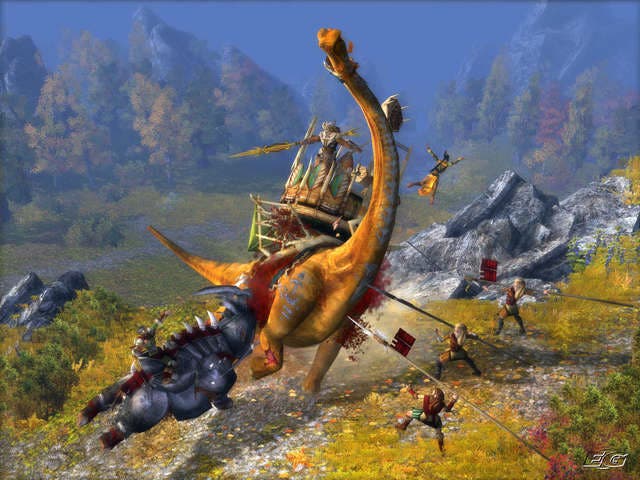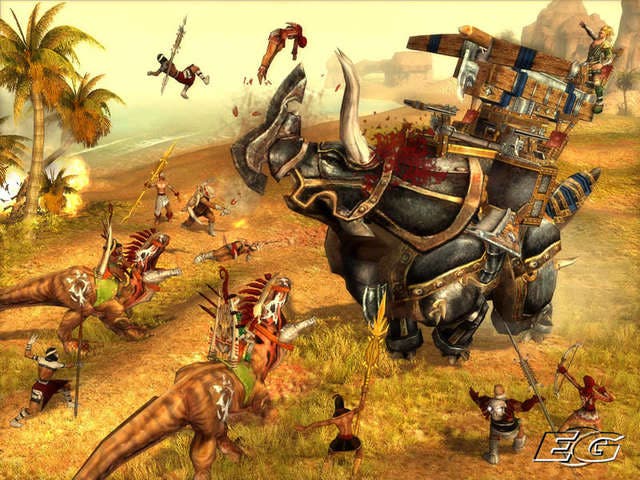ParaWorld
Stone aged.
The key question for an RTS developer these days is: what can be done that's different to the norm? Their answers have varied, though lately they've tended towards bolting a strategic framework on top of the missions, as seen in the likes of Empire at War or Rise of Legends, where the player marshals his resources and directs the war on the campaign map as well as in the real-time battles. So what does ParaWorld do differently? It has DINOSAURS! That's what. The cavalry don't just have long faces here - they've got really long necks too.
ParaWorld is set in a parallel world where the dinosaurs weren't wiped out. In its alternate dimension, the beasts continued to exist and evolve alongside man. Although you could argue that dinosaurs still exist in ours: Peter Stringfellow, Status Quo, Jimmy Saville and Barney the purple moron to name a few. And that lot are far scarier - even the sight of a stampeding horde of famished velociraptors isn't half as terrifying as the mullet king Stringfellow in a leopard-skin thong.
In all fairness, the game tries to do a little more than show off a plethora of dinosaur models (which incidentally are very smartly rendered). It also attempts to throw a spin on the traditional interface with something called the army controller. This is a panel that sits on the left hand side of the screen displaying every unit in your army. It allows you to examine your troops at a glance, complete with health bars, so battered units can be quickly identified and pulled out of battle. It's also useful for monitoring which resources your workers are gathering, and for managing promotions.
ParaWorld has a capped army size of 52, with five different ranks. Units are promoted using "skull" points which are earned from kills, and as they rise through the ranks they become more powerful (plus in the case of hero units, they acquire special abilities). A great deal of the strategy in the game revolves around promoting the right troops and achieving a good balance of infantry, ranged, siege and naval units within your 52 limit. The army controller's handy overview of your forces definitely helps this balancing act, but it's nothing revolutionary.

Working out your perfect army is a more interesting exercise due to the variety of units on the game's three sides. Do you plump for the towering brachiosaurus catapault, which can hit buildings really hard, or the more versatile ankylosaurus siege dino, which might not pack such a punch but can switch to flinging raptors at infantry? Or forget them and build a few stegosaurus transports to carry your squad of archers, letting the bowmen rain arrows down upon the enemy as they trot along. Each race plays quite differently: the norsemen are the vanilla warrior race, the dustriders are nomads with mobile bases while the dragon clan encompass an intoxicating mix of samurai, steam-punk technology and fiendish traps.
It's a shame then that the linear campaign hasn't been designed with more imaginative flair. Overall, the mission objectives tend towards that RTS formula which is as old as the dinosaurs themselves: harvest resources, build up your base, then destroy your opponent's base. A little variance is added via some sub-quests, and it's quite important to complete these, as each objective secured earns you points to spend on extra units between missions. However, these points are awarded in a seemingly haphazard manner, as missing even one small sub-quest can lead to your score being reduced to next to nothing.
And at times, the computer's AI seems on a par with its patchy maths. It tends to ignore defensive considerations, such as staying near arrow towers or behind base walls, and just chucks everything at you. Battles often turn into a boiling and bubbling mass of beasts, particularly as there are no army formations. Actually, that's not entirely true - basic formation orders can be given, but they seem to make naff all difference and in practice, troops always move in one big lump. The real skill in combat is micromanaging your unit's special powers, but sometimes these can be frustratingly difficult to target in the chaotic swirl of a melee.

There's certainly a good whack of content in ParaWorld, with sixteen chunky single-player missions and multiplayer trimmings including deathmatch, domination (capture the flag) and defender (one resource boosted player versus the rest). Unfortunately, not many people are playing online, and it can be a struggle to find an opponent.
ParaWorld isn't without its charms, particularly its diverse and enticing set of armies, but it's truly a dinosaur of an RTS, bog standard in terms of mission design and somewhat messy in the combat department. Strategy gamers expect more than this now, but even so, there are undeniable nuggets of fun to be had watching giant reptiles beat the crap out of each other.
